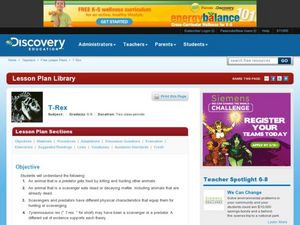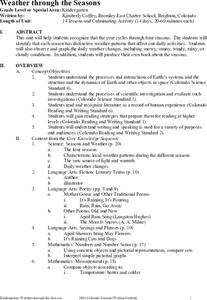Biology Junction
Energy Flow in an Ecosystem
Every living thing requires a food source, thus the interconnections in ecosystems become complex. Scholars learn about these interconnections in a presentation on energy flow. It starts with the sun and moves through many different...
Biology Junction
Energy Flow Through an Ecosystem: Food Chains, Food Webs, and Energy Pyramids
When a minnow eats a piece of plastic, that garbage often tracks through multiple animals, causing harm to each as it passes through the food chain. Scholars learn about food chains, food webs, and energy pyramids with a presentation. It...
Curated OER
Interactions of Living Things
Is it a producer, carnivore, omnivore, scavenger, or decomposer? Different relationships among organisms are explored here. It is a simple, multiple choice assignment. Use it as a quick warm-up or quiz.
Curated OER
T-Rex
Students examine the differences between a scavenger and a predator. In this predator lesson students research an animal and study its physical traits.
Curated OER
Biodiversity
In this biodiversity activity, students sort and classify animals by their observable features using a dichotomous key. Students then respond to questions about complete and incomplete metamorphosis.
Curated OER
Populations and Ecosystems
Sixth graders define terms prey, predator, and scavenger, describe predator-prey relationship, discuss effects of a lack of predators in an environment, and separate the role of the scavenger from that of the predator.
Curated OER
Weather through the Seasons
Students examine the year's cycles by observing the four seasons, their distinctive weather patterns that affect our activities and the weather changes that each brings. The fourteen lessons of this unit offer a good opportunity for the...
BioEd Online
Bio Ed Online: Food Webs
Learners construct possible food webs for six different ecosystems as they learn about the roles of producers, consumers, herbivores, carnivores and decomposers.
San Diego Zoo Global
San Diego Zoo: Tasmanian Devil
This resource provides detailed information about the warthog, as well as several pictures.
Sheppard Software
Sheppard Software: Vultures
This site gives an in-depth description of a vulture, including its behavior, appearance, and classification. The site includes photos and illustrations and an interactive quiz to test your understanding.
Curated OER
National Park Service: Moon Crater Ecosystems Lesson Plan
This is a teacher's guide to a lesson on ecosystems. The objective is for the students to set up their own ecosystem and define the roles of producers, consumers and scavengers.
Denver Zoo
Denver Zoo: Cinereous Vulture
The Denver Zoo features a comprehensive overview of the cinereous vulture focusing on its habitat, range, adaptations, diet, physical characteristics, and more.
Smithsonian Institution
National Museum of Natural History: Where Do Mammals Live?: Hyena
A brief illustrated overview of the hyena explains why this animal is such a successful dry-weather scavenger.
Northwestern University
Northwestern: What Is a Decomposer?
This concise provides a brief definition of what a scavenger is and then profiles several scavengers (flies, wasps, and cockroaches).
ClassFlow
Class Flow: Energy in the Ecosystem
[Free Registration/Login Required] This flipchart focuses on how plants and animals get energy and different habitats.
PBS
Nh Pbs: Nature Works: Scavengers
Interesting facts are presented about the cockroach, opossum, and the turkey vulture in this informative scavenger site.
















